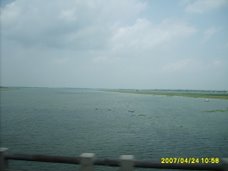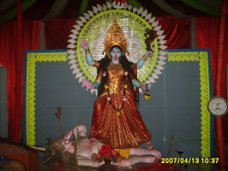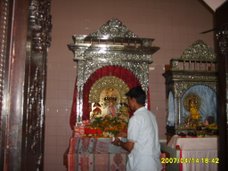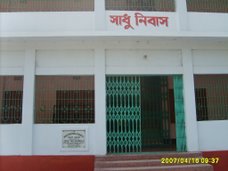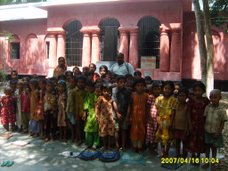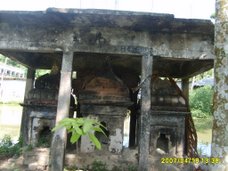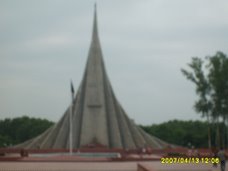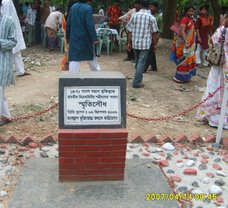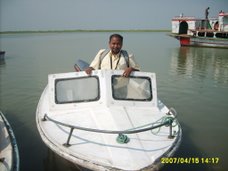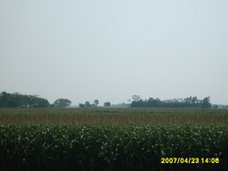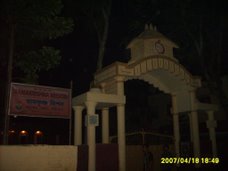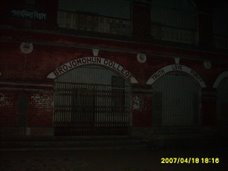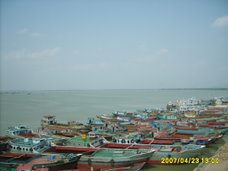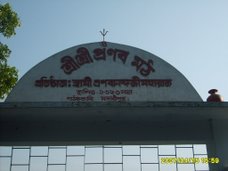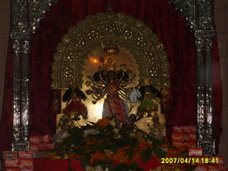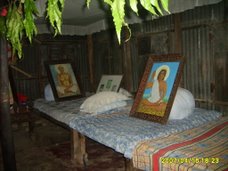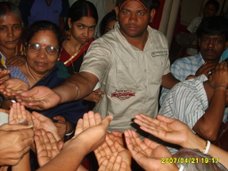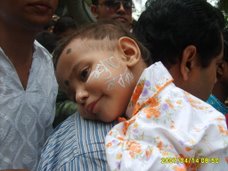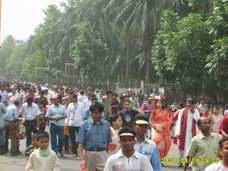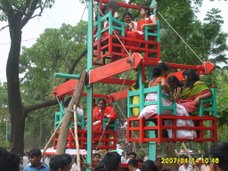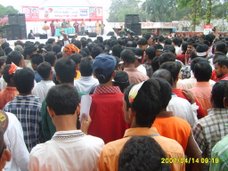
The story of my visit to our ancestors village in Gava of Barisal in present Bangladesh from where my ancestors were forced to flee at the dark of the night to save their lives and dignity.My Tour started from Dhaka and here I have tried in brief to narrate the story my visit and the truth of my ancestors Homeland lost.
DHAKESWARI TEMPLE One of the most important place of faith and worship of Hindus of East Bengal and India is the Dhakeswari temple.The city Dhaka derives its name from Dhakeswari Temple built by Raja BALLAL SEN in 12 th century CE.The Dhakeshwari Temple was severely damaged during 1971 and over half of the temple's buildings were destroyed. The main worship hall was taken over by the Pakistan Army and used as an ammunitions storage area. Several of the temple custodians were tortured and killed by the Army though most, including the Head Priest.
A significant portion of the temple land has been lost due to the Enemy Property Act and confiscation by the Bangladesh Government, and the current premises are considerably lower than the historic reach of the property.
The temple was the victim of significant vandalism during the communal attacks on the Hindu community in Dhaka in 1990 and in 1992, when property worth several million Takas was destroyed.
Since the rise of attacks on Hindu property over recent years, there has been heavy seurity of the temple complex during festive occasions like Durga Puja, are observed under police protection .
Ma Dhakeswari
RAMNA KALIBARI - (Dhaka) Ramna Kalibari Pandal(pic 5)
The Ramna Kali Mandir ( রমনা কালী মন্িদর), also known as the Ramna Kalibari was one of the most famous Hindu temples of the Indian subcontinent. It was believed to be over a thousand years old and was situated in Dhaka on the outskirts of the Ramna Park (now renamed as Suhrawardy Udyan). The temple was bulldozed by the Pakistan Army on 27th March 1971 as it commenced its genocide of the Hindu community .The temple was established by a Nepalese devotee of the Goddess Kali who had come to Bengal from the Himalayas.
The major development of the temple occurred under the patronage of Rani Bilashmoni Devi
of the Bhawal.
Next to the temple was Ma Anandamoyee Ashram , another place of worship with a residential complex . The entire temple complex spanned almost 12.25 acres .In the night of March 25th, 1971,The Pakistan army with the support of Bangaldeshi radical muslims (Rajakar and Al-Badr bahini) unleashed its inhuman terror and commenced the genocide that lasted nine months long . Prominent Hindu targets such as Jagannath hall (a hostel for Hindu students on the Dhaka University campus) and Ramna Kali Mandir were singledout right at the onset of the Islamic onslaught.On March 27th 1971, the Pakistan Army and Rajakar ,Al- Badrs entered the Ramna Kali Temple complex and within the span of an hour, murdered over 100 Hindus.
Only around 50 names of victims of the massacre have been identified; relatives of the other victims are either deceased or have left Bangladesh.
The 50 Hindus (pic-6)
Confiscation by Bangladesh Government
As a symbolic respect of the brutal Bangladesh Liberation War in which India lost an accounted 4000 soldiers, it was widely expected that the Ramna Kali Mandir would be rebuilt completely, or left in its state of ruins as a monument to the devastation and genocide. However, the new government of Bangladesh led by Sheikh Mujibar Rahman, confiscated the land of the temple from the Hindu board that had the legal ownership, and handed it over to the Department of Public Works. The government then bulldozed the last traces of the temple in 1972 and handed the land over to the Dhaka Club, an elite entertainment
and social venue. The move was

immediately protested in the courts by the Ramna Kali Mandir Board which still legally owned the premises, but the case was dismissed on the grounds that since the temple no longer existed, ownership was now disputed ( DAINIK BANGLA, 27th December 1972).
The RAMNA KALIBARI from 2001,again stands as a makeshift pandal and as a centerpoint of struggle of Hindus for freedom of religious rights in Islamic Bangladesh. Ramna Kalibari pandal(pic-7)Swami Pranabananda at Bajitpur(pic-8)
THE HINDUS IN
ISLAMIC BANGLADESH A BRIEF HISTORY (Post Partition)
Communal riots of 1950s and the atrocities on the peaceful Hindus led to the the exodus of millions of Hindu families to India. Instead of protecting the Hindus the law enforcement authority carried out large-scale oppression against them particularly against women which is evident from the resignation letter from the then Minister for Law and Parliamentary Affairs, Jogendra Mondol: “The military not only oppressed the people and took away food stuffs forcibly from Hindu houses, but forced Hindus to send their women folk at night to the camp to satisfy the carnal desire of the military”.The riots of 1950s caused mass exodus of Hindus from their homeland. Two and half million(2.5 million) Hindus left their homeland during the period of 1950-51. No political party played any role to protect the minorities and to prevent the exodus or bring them back and return their millions of acres of land and grabbed property.Other than the major riots of 1950 there had been periodical riots and continous cases of attrocities on the minority Hindus.1964 and 1965 also accounts for some major riots continuing the mass migration of Hindus to India.1971 THE SAGA OF HINDU GENOCIDE On February 22, 1971 Pakistan with the support of radical Muslim forces (Razakar and Al-Badr Bahini) launched operation Searchlight with an aim to break the backbone of the freedom movement and eradicate the Hindu population of East Bengal. "Kill three million of them," said President Yahya Khan at the February conference, "and the rest will eat out of our hands."
(Robert Payne, Massacre [1972], p. 50.) On March 25 the genocide was launched. The JAGANNATH HALL (HINDU HOSTEL) of university in Dhaka was attacked and hundreds of Hindu students were brutally murdered . Death squads of Razakars and Al-badrs roamed the streets of Dhaka, killing some 5,000 Hindus in a single night. But,it was only the begining. "Within a week, the entire Hindu population of Dhaka had fled, and at least 30,000 people had been killed. Chittagong, too, lost half its population. All over East Pakistan Hindus werekilled,their women raped, HINDU HOUSES WERE PAINTED WITH YELLOW "H"s, ROBBED OF THEIR LANDS AND SHOPS, AND WERE SYSTEMATICALLY SLAUGHTERED.In the 9 months of repression that followed The total migration of Hindu population from East Bengal(Pakistan) to India accounted to some more than 8 millions with 2.5 Million Hindus being killed.
Dr. Viggo Olsen in his book "DAKTAR" on persecution of Hindu women in East Pakistan has given an account of Hindu women in 1971 ."Although thousands of young Hindu women were killed, the most attractive among them were captured to become sex slaves in the military cantonments. When the girls tried to hang themselves with their clothing, their garments were taken away from them. Then, when they tried to strangle themselves with their long black hair, they were shaved bald. When they became five or six months pregnant, they were released with the taunt: 'When my son is born, you must bring him back to me'." (DAKTAR BY VIGGO OLSEN).
The latest massacares - Post election 2001Since the terror began in early October 2001 well over 65 thousand Hindu families fled from Bangladesh to India; over 2 thousand women were raped; over 185 Hindu political opponents were killed; over 5260 were injured; over 9,000 Hindu houses have been burnt; punitive taxes are levied against, without allowing that population any form of recourse; acres after acres of paddy harvest have been expropriated, and thousands of temples were desecrated. The Hindu-dominated areas in Barisal, Bhola, Pirojpur, Satkhira, Jessore, Khulna, Kushtia, Jhenaidah, Bagerhat, Feni, Tangail, Noakhali, Natore, Bogra, Sirajganj, Munshiganj, Narayanganj, Narsingdi, Brahmanbaria, and Chittagong were the worst hit. The Bangladesh Observer reported that at least 10,000 people of the minority community from Barisal district ran away from their homes following attacks by the Muslim community and took shelter in neighbouring Gopalganj district. Many others fled to the Indian State of Tripura and West Bengal. Shoulder to shoulder we stand together
(pic -12)
WHITHER BANGLADESH
Bangladesh has been quite successful in achieving gradual denudation of its Hindu population. At the time of country's partition, the Hindu population in East Pakistan was 11.4 million or 29.17 percent of the total population. It has decreased alarmingly over the last few years and stood at 15.6 million in 2001. In other words it has come down to 10 per cent of Bangladesh's total population of 140 million. The Hindu population however, should have been 54.4 million in Bangladesh in 2001 as per the normal annual growth rate of 1.9 percent and had been no migration of Hindus. In this connection, relevant part is quoted here from a report titled "The Missing Population" dated January 7, 1994 from "Holiday"-a prestigious weekly of Dhaka:
"The Missing population of Hindus was about 1.22 million during the period of 1974-81, about 1.73 million during the last inter-censal period of 1981-1991."after the liberation of Bangladesh.
The massacare of the peaceful Buddhist, Chakma population in the Chittagong Hill tracts by the Bangladesh Army has led to the exodus of millions of Chakmas to North-East Indian states. Apart from this Bangladesh have already sent approximately 3o million Muslim infiltrators to India,who have already reached a demographic majority in seven districts of Assam,three districts of West Bengal and Kisanganj district in Bihar.
Year--- Muslim- (%)- Hindu
1951----- 74.9 ---------- 25.1
1961----- 80.4----------- 19.6
1974------85.4-----------14.6
1981----- 86.6----------- 13.4
1991----- 87.4----------- 11.6
The ruined Nandy house in Komilla(pic-13)
FROM DHAKA TO BARISAL. (pic-14) Barisal once called the granary of Bengal is a main city and district of southern Bengal. . The city lies in the Padma (Ganges) River delta on an offshoot of the Kirtonkhola River. In 1876 back, Barisal was incorporated into a municipality.
Due to its location and easy access to both riverine and marine navigation channels, it is a major transshipment center for rice, hides, and pulses. Bakery, textile . It is linked by steamer with Dhaka (73 miles [117 km] north) and with Chittagong to the southeast. Road communication has improved in the last decade with building of few bridges.Barisal District is divided into the following subdivisions ,Barisal Sadar, Agailjhara, Babuganj, Bakerganj, Banaripara, Gaurnadi, Hizla, Mehendiganj, Muladi, and Wazirpur.
Ma Barisal Kali(pic-15) BARISAL- THE GRANARY OF BENGALThe Barisal town is one of the prime business centers of East Bengal and the first impression of the town would give one a ready answer about the struggling economic condition of West Bengal.The richness of the town,the huge markets, gigantic stores, all showed the enormous capacity of business that the town possessed.Barisal district once called the granary of Bengal was demographically a Hindu majority district back in 1940s.More than 45%shops in Barisal still belong to Hindus.I went to some big Hindu shops and had discussions with them.Like all the able Hindus of Bangladesh everyone have an address in India. Even ten years back almost 65% of the shops in Barisal town belonged to Hindus.But intense communal pressure,terror and anti-Hindu policies of Bangladesh Government are everyday forcing the Hindus of Barisal to sell away their shops and business and leave secretly for India.I also visited The Barisal Kalibari which was desecrated in the riots of 1992 and the Dharmarakhshini Sabha established by the prominent Hindus of Barisal back in1925 to resist the apparent Islamic onslaught.
FROM BARISAL TO GAVA
From the Barisal city ,the town of Banaripra is 30 kms and just about 2 kms before Banaripara there is a diversion in the left.The entire area would show remnants of its rich past but all in ruins now and following this historical brick road for another 1 km is the famous village, Gava the acestral abode of the Ghosh Dastidars.
 Brojo Mohun College (pic 18)The Ghosh Dastidars of GAVA
Brojo Mohun College (pic 18)The Ghosh Dastidars of GAVA Ghosh Dastidar,my family name ,I have heard so much about it in my childhood from my grandfather, father,uncles and other relatives,our rich cultuarl hertage,our history,our ancestors,the beautiful Gava village,where they lived together happily and from where my Grandfather Late Ramendranath Ghosh Dastidar and our family had to migrate in 1947.My Grandfather was the H.O.D of English in BARISAL BROJOMOHUN COLLEGE at that time.The much I have heard about the history of my family is that our ancestor Late Makaranda Ghosh from Kanauj was a general and minister of King Ballal Sen and we were fighting for three generations with the Delhi Sultanate to protect Bengal but, after the fall of Nortern and Central India the rich lands of Bengal come under tremendous attacks from all sides and when Keshab Sen finally lost to Bukhtiyar Khilji after continous three years of fighting from 1201 to 1204,Bengal was in ruins.The Kayasthas (Bengali Khatriyas) who were then tired of fighting and the dangerous barbarism on the general bengali population by the muslim hordes made the heads of the Hindus to sign a treaty with the Muslims (who were then also quite scared of the fighting spirit and skills of the Bengali Kayasthas)Our ancestor Late Ramkrishna Ghosh was awarded the tiltle "Dastidar" at some point of time after this age and Dastidar means "Keeper of the Royal Seal"and from there our family tree starts ."Every Ghosh Dastidar you find in this world are realtives and come from the same family and whenever you find someone say that your parjay is 24 " my Grandfather told me.
Beautiful Sandhya Nadi( pic -19)
He also said the name of the village GAVA has derived its name due to its rise from the Garva(inside) of Sandhya Nadi( river).I used to ask my jethu (uncle) Late Debdas Ghosh Dastidar "Which place is better?"Kolkata or Gava.He would say loudly "GAVA,GAVA,GAVA". Then he would get out a very old, hardly rocognisable, black and white photograph from his closet and say with a smile "This is GAVA.The best place."My uncle never married ,he was the elder brother and like thousands of elder brothers and sisters of refugee families, hesacrificed his life for our family ,to raise his youngers,my father and other uncles.Today we live in a lot of luxury.Our problems have changed. How to I find a parking, for my car in office hours?How could I manage some extra time for my friends?But,the life of extreme toil taken by my uncle, Late.Dr.Debdas Ghosh Dastidar for us ,seldom comes to my mind.He is my childhood friend and the major inspiration of my life .
The Gava High Eng School(pic-20)
THE GAVA VILLAGE - "Pallaba Ghana Amra Kanan Rakhaler Khela Geha,Stabdha Atal Dighi Talamal Nisithasital Sneha". The Gava village road(pic -21)
The two things that are foremost noticeable in Gava are its striking greenery and the beautful GAVA River which flows through the heart of GAVA Village. All the Ghosh Dastidar families had their houses on two sides of the Gava River which is not very wide but, quite deep.All most all the houses had their own personal ghats with the Gava river.My Uncle told me that during the full moon nights of summer they used to go for sailing on the boats,with khol and kartal,singing Kirtan and people gathered on the two sides of the river to listen.
Though much of the Gava village is in ruins ,which speaks of its glorious days and shows that it was once a perfect model village from all angles.There is an English medium High School in the village.
"Gava High English School" was established in 1889 by the Ghosh Dastidars and still providing quality education to the students.Many famous ancestor of ours studied and taught in this school.A fully operative post office was also there but now closed.There is only oneGhosh Dastidar family left in the entire village.Sri Sukanto Ghosh Dastidar and his family received me like a long lost family member and showed me round our ancestral village.
He told me about the difficult conditions that they have to live through.All the other family members have left ,there were about four Ghosh Dastidar families in Gava, but after the atrocities of 2001 ,only he and his elder brother Hari Ghosh Dastidar's family had come back to stay in Gava. Through out Bangladesh I have stayed in different places,tasted different cuisines but there is one thing unique about Gava village.Its climate,water,taste of food everything appeared perfect for me.I felt as if the place is known to me for a long long time.Like I have reached my home and my mother is waiting for me. The cool breeze,the huge mango trees,the kingfishers by the river side,the moisture withinthe air,the temperature in the atmosphere,was perfectly comaptible with me and everything told me that it is my home,my habitat,the place where I belong.Like a flash my Jethu's words came back to my mind, "Gava,Gava,Gava.It is the best palce in the world". After a wonderful lunch at Sukantoda's house we went to see round our ancestral village.
The house of famous actor Rabi Ghosh Dastidar,famous mathematician and scholar,Debaprasad Ghosh Dastidar,beautiful structures,still narrating our history.My father told me that our house was beside Daroga Ghosh Dastidar's house and there was a beautiful temple near to our house.Here, I found alarmingly, that all the houses have not only been demolished ,but the famous Pancharatna temple of
the Ghosh Dastidars have been desecrated and being changed into a Madrasa and Mosque by the Bangladesh Government.
The signboard put by the Bangladesh Government on the Hindu Temple is a demonstartion its flamboyant anti-Hindu,radical Islamic policy.The most difficult thing was saying Good Bye to Gava.I stood by the side of the Gava River .The sun was going down in the horizon,boats full of grains,bananas and vegetables sailing slowly towards the Kirtankhola River to reach Barisal town .I closed my eyes and chanted Vedic Shanti Mantra in my mind towards my ancestors and tried to imagine a picture of the Gavavillage 60 years back,with all the families living together,in this beautiful place and the love and bondage they shared.With a heavy mind I sat back in the car.The Gava village and the waving hands of my relatives were slowly disappearing as the taxi sped along Banaripara Road towards the Barisal Town.
I do not know when I would be able to come back,but Gava would be forever there with me,guiding my intellect,inspiring my actions, and showing the way towards a brighter future.The future that we have to present to our future generations to come.













